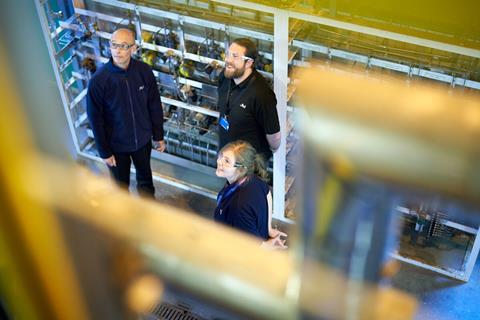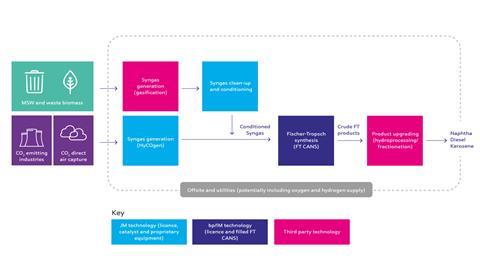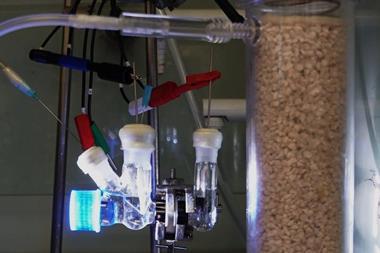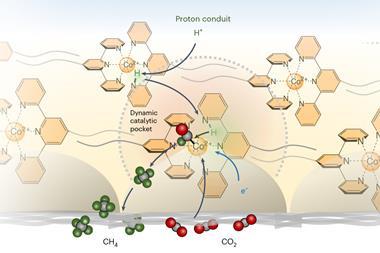Air travel is no longer a luxury commodity but a foundational part of modern transport systems. Aviation’s role in tourism will be familiar to many people, but it’s important to note that air transport carries around 1% of the volume of world trade shipments and up to 35% of the value.
However, combatting the climate crisis and achieving the 1.5°C pathway outlined in the Paris Agreement requires rapid decarbonisation across the world’s major industries, such as the chemical, energy and fuel sectors. In 2022, it was estimated that 91% of global GDP is now covered by a national net zero target, up from 16% in 2019. Yet, despite these ever-increasing pressures to achieve net zero carbon emissions, decarbonisation remains a monumental challenge.

Johnson Matthey (JM), a global leader in sustainable technologies, is well placed to take on this challenge and help reduce emissions in the aviation industry. Our HyCOgen™ technology has leveraged JM’s longstanding legacy in innovative technologies and industry leading experience to deliver a sustainable aviation fuel solution that is viable for the business needs of today and tomorrow.
Enabling the production of sustainable fuels
Since commercial flights began, fossil fuels have become deeply embedded in processes and fuels that power aeroplanes. But looking ahead, future demand for hydrocarbon-based fuels is not guaranteed. Moreover, both internal business pressures to be more socially responsible and tightening government regulations will inevitably drive demand for sustainable fuel production.
Conventional aviation fuel is usually petroleum-based, made by refining various crude oil petroleum distillation products such as naphtha, gasoline or kerosene. Currently, 12% of transport-related carbon dioxide emissions come from aviation; this has to change.
In response, the International Air Transport Association has committed to net zero carbon emissions from aviation by 2050. As such, businesses need a route to secure future revenue streams if they are going to remain relevant.

To do this, the energy and fuel sectors are increasingly looking to combine alternative sustainable feedstocks, such as biomass and waste, with catalyst and process technologies to deliver sustainable aviation fuels (SAFs). These fuels offer the performance of petroleum-based fuels at a fraction of the carbon footprint. Often, they are blended with conventional aviation fuels in order to improve the sustainability of air travel.
With the ability to integrate seamlessly with existing infrastructure, thereby reducing costs, SAF drop-in liquid hydrocarbon fuels remain the only practical means of powering commercial aircraft while fulfilling the demand for increased sustainability across the sector. Therefore, creating a scalable production method for SAF drop-in fuels is paramount.
Catalysing the transition
Synthesis gas (syngas) is a valuable building block in creating sustainable aviation fuels. It is essential in enabling the decarbonisation of chemical processes because it can be made from alternative, more sustainable feedstocks, such as captured CO2. Once created, syngas can be converted to synthetic crude oil via the Fischer–Tropsch reaction, which can then be upgraded into sustainable aviation fuel.
Leveraging our position as a leader in catalyst, syngas and hydrogen technologies, JM has developed HyCOgen reverse water–gas shift technology. This is designed to convert CO2 – either from direct air capture or from emissions that would otherwise be released into the atmosphere – and green hydrogen into carbon monoxide, which is then combined with additional hydrogen to create syngas.
The reverse water-gas-shift reaction
JM’s HyCOgen technology uses the reverse water-gas shift reaction to convert green hydrogen and carbon dioxide into carbon monoxide.
H2(g) + CO2(g) → CO(g) + H2O(g) [Catalysed with a JM catalyst]
The ‘original’ water–gas shift reaction was first discovered in 1780 by physicist Felice Fontana and involves reacting carbon monoxide and steam to produce hydrogen and carbon dioxide. Today, it’s an established chemistry used in hydrogen production. However, with a highly developed understanding, it is possible to leverage the reverse reaction – converting carbon dioxide into carbon monoxide using hydrogen.
The reaction requires heat, and JM uses its in-depth knowledge and knowhow to provide the heat energy efficiently, which reduces both capital and operating expenditure.
Partners in scale
Navigating change is never easy. And to meet the aviation industry’s environmental goals, innovative solutions aren’t enough. To succeed, we’re strategically building partnerships, projects and technology pathways across the industry to provide solutions at the scales that are needed.
Critically, JM’s HyCOgen technology fully integrates with JM and BP’s award-winning FT (Fischer–Tropsch) CANS™ technology, which converts syngas directly into high-quality synthetic crude oil. The end-to-end process enables a cost-effective and scalable means to transform over 95% of CO2 entering the process into high-quality synthetic crude oil (which can go on to create sustainable drop-in fuels like SAF).

Integrating these two technologies results in a convenient, streamlined way to develop sustainable synthetic crude, ready for upgrade into drop-in fuels used in road vehicle engines, ships and aeroplanes. It also provides a way for existing operators to transition toward greener practices gradually.
Already, our HyCOgen technology and co-developed FT CANS technology have been selected for use by Aramco and Repsol at a new synthetic fuels plant in Bilbao, Spain. The site is one of the world’s first to use renewable (green) hydrogen and CO2 as its only raw materials. This application is just one example of how JM is following through on its commitment to create a better, more sustainable tomorrow, today.
By identifying the fundamental need and demand for decarbonisation in the aviation industry, JM strives to commercialise the HyCOgen technology rapidly. Understanding the market’s needs, JM can better support the industry, solve problems and provide solutions that benefit everyone.
Complex problems require problem solvers
Creating cutting-edge technologies to solve problems effectively requires expertise, collaboration and drive. The development of JM’s HyCOgen technology incorporated all three:
- Expertise derived from JM’s legacy across syngas and catalyst technologies;
- Collaboration across JM’s teams fostered by our engaging working environment;
- A drive to leave behind a better, more sustainable world.
While this helped create our sustainable HyCOgen technology, it also reflects JM’s overall approach to developing new technologies and solving problems across many industries.
By leveraging JM’s history and expertise, HyCOgen technology has emerged as a natural evolution of existing JM innovations, all of which have been proven commercially at scale. This means that processors can be assured of process performance and JM’s capabilities to launch and support innovative technologies to market.
The industry is changing, and it’s up to businesses to take the initiative
Collaboration is another cornerstone of JM’s approach to developing HyCOgen technology. To be able to take on the most challenging problems, businesses need to get the most out of their teams’ expertise, thereby delivering better results and happier employees. For example, during the development of our HyCOgen technology, interdisciplinary collaboration was instrumental. The reverse-water-gas-shift reactor had design challenges associated with the high-temperature operation and flammable/toxic gases. A team of process, material and mechanical engineers was assembled to solve these issues, determining the appropriate metallurgy to ensure safe operation. The success of this demonstrates why JM is keen to foster a positive workplace across different teams. Driving innovation is becoming increasingly interdisciplinary, especially as the industry’s challenges become more complex. It’s a natural step to be ready for that.
A sustainable tomorrow, today
The next decade will see the pressure to create a more sustainable world rise to levels we’ve never seen before. But JM is prepared and possesses the right tools to catalyse the transition to net zero with innovative, cutting-edge solutions. By identifying the needs and developing a solution that requires little additional infrastructure, JM is readily solving problems within the transportation industry.
This dedication isn’t just found within our innovative, cutting-edge solutions either. By carrying it forward within JM’s values, it allows us to unlock the full potential of our talented team of scientists and engineers. Through our technologies and across a wide range of industries, we are solving problems and creating a cleaner, healthier world.
We’re in a transitory time. The industry is changing, and it’s up to businesses to take the initiative to change alongside it. Demand for sustainable fuels will only intensify. Therefore, it’s essential to work with companies that prioritise sustainability, understand what the industry needs, and have the expertise to create these solutions today.
Paul Ticehurst - Senior business development manager, Johnson Matthey

Paul has over 25 years of experience developing process-based projects, working throughout Europe and the US. At Johnson Matthey, he has commercial responsibility for the Fischer-Tropsch CANSTM technology jointly licensed with BP and Johnson Matthey’s HyCOgenTM reserve water gas shift technology. He holds a Bachelor’s degree in Chemical Engineering with Minerals Engineering from the University of Birmingham and an MBA from Kingston University.













No comments yet